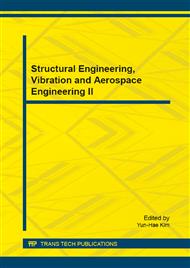p.230
p.238
p.242
p.250
p.256
p.261
p.265
p.271
p.275
The Similar Relationship Research of the L-Type Eccentric Structure Model on Vibration Test
Abstract:
Vibroplatform test is an important means of testing the dynamic characteristics of the laboratory sim-ulating structure under seismic action. For structure whose volume and weight exceed the limits of vibroplatfor-m tests is usually carried out through model test according to the similarity theory. So how to deal with the simil-ar relationships among the test model and how to verify thethe rationality of vibration control strategy through testing results become the key and fundamentalproblems. 1:15 scaled models will be made through the dimensional analysis based on a 4 layersL-shaped frame structure as the proto-type , which are made from micro-concrete, aluminum alloyand plexiglass. SFMT sap2000 is used to make a dynamic analysis to get the values of period,acceleration, velocity, etc. Comparing the results of prototype inferred from model through similarrelationship with theoretica-l values of prototype to get the correct formula and confirm the bestscaled model and then provide references f-or model test later.
Info:
Periodical:
Pages:
256-260
Citation:
Online since:
January 2015
Authors:
Price:
Сopyright:
© 2015 Trans Tech Publications Ltd. All Rights Reserved
Share:
Citation:


